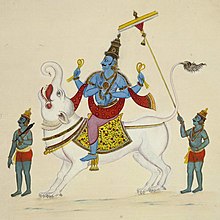
Back Varuna ALS فارونا Arabic বৰুণ Assamese Varūna BAT-SMG Varuna BCL Варуна Byelorussian वरुण Bihari বরুণ (দেবতা) Bengali/Bangla Varuna Breton Varuna Catalan
| Varuna | |
|---|---|
God of the Sky,[1] Oceans, and Water | |
| Member of Adityas | |
 Varuna on his mount Makara | |
| Affiliation | Adityas, Deva, Dikpala |
| Abode | Ocean |
| Mantra | Oṃ jala bimbāya vidmahe nīla puruṣāya dhīmahi tanno varuṇaḥ pracodayāt Oṃ Varunāya Namaḥ |
| Weapon | Noose, Varunastra, Gandiva |
| Mount | Makara |
| Personal information | |
| Parents | |
| Spouse | |
| Children | |
| Equivalents | |
| Greek equivalent | Poseidon |
| Roman equivalent | Neptune |
| Norse equivalent | Njörðr |
Varuna (/ˈvɜːrʊnə, ˈvɑːrə-/;[5] Sanskrit: वरुण, IAST: Varuṇa) is a Hindu god, associated with the sky,[6] oceans, and water. In the Vedic scriptures, he is paired with the god Mitra and is the lord of Ṛta (justice) and Satya (truth).[7][8] Varuna is also mentioned as an Aditya, the sons of the goddess Aditi.[9]
In the later Hindu texts like the Puranas, Varuna is also a Dikpala or guardian of the western direction. He is depicted as a youthful man, mounted on Makara (crocodile) and holding a Pasha (noose, rope loop) and a pitcher in his hands.[7][10][8] He has multiple wives and fathered many children, including the Vedic sage Vasishtha.[7]
He is also mentioned in the Tamil grammar work Tolkāppiyam, as Kadalon the god of sea and rain.[11] He is found in Japanese Buddhist mythology as Suiten.[10] He is also found in Jainism.[12][13]
- ^ Bauer, Susan Wise (2007). The History of the Ancient World: From the Earliest Accounts to the Fall of Rome (1st ed.). New York: W. W. Norton. p. 265. ISBN 978-0-393-05974-8.
- ^ a b Mani, Vettam (1975). Puranic encyclopaedia : a comprehensive dictionary with special reference to the epic and Puranic literature. Robarts - University of Toronto. Delhi : Motilal Banarsidass.
- ^ G.V.Tagare (1958). Brahmanda Purana – English Translation – Part 3 of 5. pp. 794.
- ^ www.wisdomlib.org (2017-10-09). "Stuta, Stutā: 5 definitions". www.wisdomlib.org. Retrieved 2020-01-15.
- ^ "Varuna". Random House Webster's Unabridged Dictionary.
- ^ Bauer, Susan Wise (2007). The History of the Ancient World: From the Earliest Accounts to the Fall of Rome (1st ed.). New York: W. W. Norton. p. 265. ISBN 978-0-393-05974-8.
- ^ a b c George Mason Williams (2003). Handbook of Hindu Mythology. ABC-CLIO. p. 294. ISBN 978-1-57607-106-9.
- ^ a b James G. Lochtefeld (2002). The Illustrated Encyclopedia of Hinduism: N-Z. The Rosen Publishing Group. p. 741. ISBN 978-0-8239-3180-4.
- ^ Dalal, Roshen (2010). Hinduism: An Alphabetical Guide. ISBN 9780143414216.
- ^ a b Adrian Snodgrass (1992). The Symbolism of the Stupa. Motilal Banarsidass. pp. 120–122 with footnotes. ISBN 978-81-208-0781-5.
- ^ Journal of Tamil Studies. International Institute of Tamil Studies. 1969. p. 131.
- ^ Sehdev Kumar (2001). A Thousand Petalled Lotus: Jain Temples of Rajasthan : Architecture & Iconography. Abhinav Publications. p. 18. ISBN 978-81-7017-348-9.
- ^ Kristi L. Wiley (2009). The A to Z of Jainism. Scarecrow. p. 248. ISBN 978-0-8108-6821-2.
© MMXXIII Rich X Search. We shall prevail. All rights reserved. Rich X Search